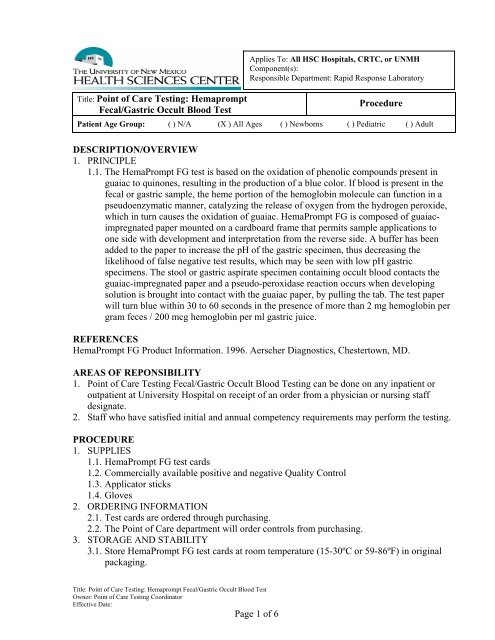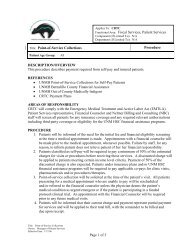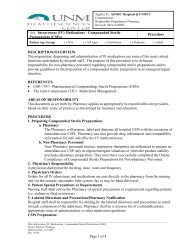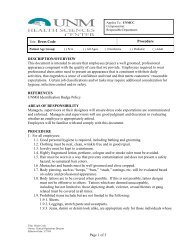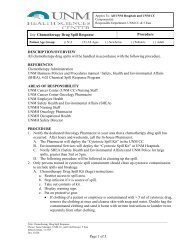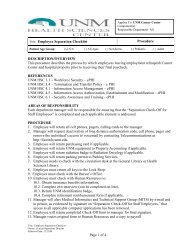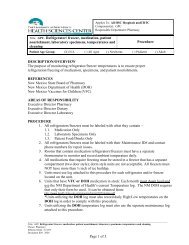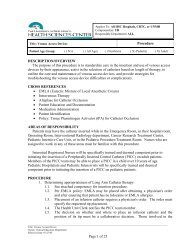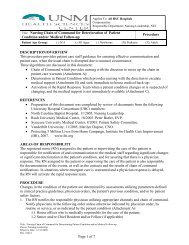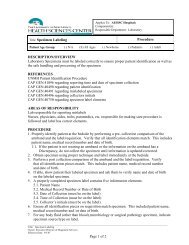Page 1 of 6 DESCRIPTION/OVERVIEW 1. PRINCIPLE 1.1. The ...
Page 1 of 6 DESCRIPTION/OVERVIEW 1. PRINCIPLE 1.1. The ...
Page 1 of 6 DESCRIPTION/OVERVIEW 1. PRINCIPLE 1.1. The ...
You also want an ePaper? Increase the reach of your titles
YUMPU automatically turns print PDFs into web optimized ePapers that Google loves.
7. PATIENT MANAGEMENT7.<strong>1.</strong> Patient Identification7.<strong>1.</strong><strong>1.</strong> Patient identification may be the patient’s name, date <strong>of</strong> birth, medical recordnumber or assigned trauma alert name.7.<strong>1.</strong>2. UNMHSC does not recognize a patient’s social security number or room numberas a patient identifier.7.2. Patient Preparation7.2.<strong>1.</strong> Fecal specimen7.2.<strong>1.</strong><strong>1.</strong>It is recommended that the patient be placed on a high residue diet for twodays before collecting the stool specimen. Eliminate red meat, raw fruit, andvegetables high in peroxidase (broccoli, cauliflower, parsnips, turnips, redradishes, and horseradish). Drugs to avoid that could interfere with test resultsinclude the following: Vitamin C, alcohol, aspirin, Iron, Ibupr<strong>of</strong>en, Naproxinand other arthritis medicines. However, the special diet may be omittedinitially with diet restrictions imposed upon re-testing <strong>of</strong> all positive results.7.2.<strong>1.</strong>2.Stool samples from three consecutive bowel movements or three bowelmovements closely spaced in time should be collected.7.2.<strong>1.</strong>3.Collect specimens in a clean specimen collection container with a screwcappedtop.7.2.<strong>1.</strong>4.Alternately, the stool sample may be applied directly to the HemaPrompt FGtest card after performing a rectal examination.7.2.2. Gastric7.2.2.<strong>1.</strong>Gastric contents obtained from a naso-gastric tube or vomitus may be applieddirectly to the HemaPrompt FG test card from the NG tube or by means <strong>of</strong>cotton tipped swab.8. SPECIMEN COLLECTION AND HANDLING8.<strong>1.</strong> Standard precautions apply to all point <strong>of</strong> care tests.8.2. Testing personnel should handle all patient samples as per the Bloodborne PathogenExposure Plan.8.3. <strong>The</strong> Hemaprompt test requires only a small fecal specimen. <strong>The</strong> specimen is applied tothe guaiac paper <strong>of</strong> the Hemaprompt Slide as a thin smear using the applicator stickprovided.8.4. Slides containing samples may be stored for up to 5 days at room temperature (15° to30°C) before developing.9. SPECIMEN LABELING9.<strong>1.</strong> Specimens for testing should be immediately placed onto the Hemoccult test card.9.2. Specimens should be tested immediately at the patient’s bedside and discarded.9.3. If immediate bedside testing is not possible, the card should be labeled with two uniqueidentifiers.9.4. Patient identification may be the patient’s name, date <strong>of</strong> birth, medical record number orassigned trauma alert name.9.5. UNMHSC does not recognize patient’s social security number or room number as apatient identifier.10. PATIENT TESTING10.<strong>1.</strong> Open the Hemaprompt FG test card so both specimen windows are visible.10.2. Apply the specimen to the test card windows10.3. Fecal Specimen:Title: Point <strong>of</strong> Care Testing: Hemaprompt Fecal/Gastric Occult Blood TestOwner: Point <strong>of</strong> Care Testing CoordinatorEffective Date:<strong>Page</strong> 3 <strong>of</strong> 6
10.3.<strong>1.</strong> Using Universal Precautions, collect a small fecal sample on the applicator stickprovided in Hemaprompt FG kit.10.3.2. Apply a very thin smear <strong>of</strong> stool to the first window (do not completely coverwindow)10.3.3. Reuse applicator to obtain a second sample from a different part <strong>of</strong> the specimen.10.3.4. Apply a thin smear to the second window (do not completely cover window).10.3.5. Close the cover <strong>of</strong> the test card, avoiding finger pressure to card.10.3.6. Turn the card over to the back. Holding the card facing you, gently lift up thesilver tab so that the white developer pad is exposed.10.3.7. While gripping the tab with thumb and finger <strong>of</strong> other hand, slowly and steadilypull the long silver tab all the way to the right and completely remove it from thetest card.10.3.8. Wait one minute after pulling tab before interpreting the test result.10.3.9. Dispose <strong>of</strong> test card and applicator stick in biohazard container.10.4. Gastric Specimen:10.4.<strong>1.</strong> Using Universal Precautions, collect and apply a thin smear <strong>of</strong> specimen directlyfrom NG tube or by means <strong>of</strong> a cotton tipped applicator.10.4.2. Apply gastric specimen to both windows on the test card (do not completely coverwindow)10.4.3. Close the cover <strong>of</strong> the test card, avoiding finger pressure to card.10.4.4. Turn the card over to the back. Holding the card facing you, gently lift up thesilver tab so that the white developer pad is exposed.10.4.5. While gripping the tab with thumb and finger <strong>of</strong> other hand, slowly and steadilypull the long silver tab all the way to the right and completely remove it from thetest card.10.4.6. Wait one minute after pulling tab before interpreting the test result.10.4.7. Dispose <strong>of</strong> test card and applicator stick in biohazard container.1<strong>1.</strong> INTERPRETATION1<strong>1.</strong><strong>1.</strong> Positive - Any blue color in either specimen window. Look for any shade <strong>of</strong> blue, evenif only a faint tinge.1<strong>1.</strong>2. Negative - No detectable blue color on either window.12. REFERENCE RANGE12.<strong>1.</strong> A normal occult blood test is negative for blood.13. RESULT REPORTING13.<strong>1.</strong> Patient results should be immediately reported in the permanent medical record.NORMAL RANGE:• A normal fecal screen for occult blood is negative.• A normal gastric screen for occult blood is negative.14. LIMITATIONS14.<strong>1.</strong> Stool samples should not be collected if the patient is experiencing menstrual bleeding,constipation bleeding, bleeding hemorrhoids or when rectal suppositories or medicationis being used.14.2. Gastro-intestinal cancers, adenomas and ulcerations do not always bleed.14.3. Blood if present, may not be distributed uniformly in the fecal specimen. Consequently,a test result may be negative even when disease is present.14.4. HemaPrompt test cards are designed for preliminary screening as an aid to diagnosis.Title: Point <strong>of</strong> Care Testing: Hemaprompt Fecal/Gastric Occult Blood TestOwner: Point <strong>of</strong> Care Testing CoordinatorEffective Date:<strong>Page</strong> 4 <strong>of</strong> 6
14.5. <strong>The</strong>y are not intended as a replacement for other diagnostic procedures. Further testingand examination by the physician such as gastroscopy, sigmoidoscopy, barium enema,and x-ray studies need to be performed to determine the exact cause and source <strong>of</strong> theoccult blood in the stool/gastric specimen.14.6. HemaPrompt test results are to be read 1 minute after pulling the gray tab. After 5minutes, intensity <strong>of</strong> blue color may decrease or fade, and possibly appear negative.14.7. Gastric samples may occasionally appear green or blue when applied to the test card.14.7.<strong>1.</strong> When this occurs, care must be taken that only the formation <strong>of</strong> additional bluecan be regarded as positive.15. INTERFERING SUBSTANCES15.<strong>1.</strong> Fecal specimens15.<strong>1.</strong><strong>1.</strong> Red and rare meats, horseradish, raw fruits and vegetables such as broccoli,cauliflower, red radish, cantaloupe, parsnips and turnips, or other high peroxidasecontaining vegetables, which can cause false positive results.15.<strong>1.</strong>2. Certain medications such as aspirin, indomethacin, phenylbutazone, reserpine,corticosteroids and non-steroidal anti-inflammatory drugs can causegastrointestinal bleeding and give false positive results. Iron containingcompounds may cause false positive results.15.<strong>1.</strong>3. Vitamin C in dosages greater than 250 mg per day has been shown to cause falsenegative results.15.2. Gastric specimens15.2.<strong>1.</strong> All foods and medications listed above may cause false positive (or negative)results in gastric specimens.15.2.2. Cimetidine (Tagamet) may cause false positive results.CLIA ClassificationUseIf definitive how will results beused?WaivedScreenResult is used to determine blood in stool or gastric fluid.DEFINITIONSNoneSUMMARY OF CHANGESReplaces POCT Hemaprompt Fecal/Gastric Occult Blood Test, in use 3/13/06KEY WORDSOccult blood, fecal occult blood, gastric occult bloodRESOURCES/TRAININGResource/DeptPoint <strong>of</strong> Care Testing 272-0980Internet/LinkTitle: Point <strong>of</strong> Care Testing: Hemaprompt Fecal/Gastric Occult Blood TestOwner: Point <strong>of</strong> Care Testing CoordinatorEffective Date:<strong>Page</strong> 5 <strong>of</strong> 6


